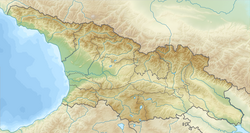Satsurblia Cave
| Region | Sataplia-Tskaltubo karst massif |
|---|---|
| Coordinates | 42°22′38.05″N 42°36′3.40″E / 42.3772361°N 42.6009444°ECoordinates: 42°22′38.05″N 42°36′3.40″E / 42.3772361°N 42.6009444°E |
| Altitude | 360 m (1,181 ft) |
| Type | karst cave |
| Length | 125 m |
| History | |
| Periods | Late Upper Paleolithic |
| Site notes | |
| Excavation dates | 1976, 1985–88, 1989–1992, 2008–2010, 2012–2013 |
| Archaeologists | A. N. Kalandadze, T. Meshveliani |
Satsurblia Cave is a paleoanthropological site located near Kumistavi village, Tskaltubo district, in the Imereti region of Georgia. The karst cave was first excavated in 1976 by A. N. Kalandadze.
Prehistoric people first occupied the cave from around 25,500 to 24,400 BP. The next period of human occupation at Satsurblia took place from around 17,000 to 16,200 BP. The hiatus in human occupation at Satsurblia coincides with the Last Glacial Maximum.
Lithic artefacts, bone artefacts, charcoal, flax fibers, and pottery were discovered at the cave. The lithic artefacts show similarities to eastern Epigravettian sites. Perforated pendants made out of stalagmite and polished bovid bone were also discovered. The remains of yellow, red and brown ochre were also found at the site.
Unlike most other Paleolithic sites found in Georgia that relied primarily on hunting one species, the people of Satsurblia appeared to have hunted a slightly more diverse range of species. The animal remains found at Satsurblia were dominated primarily by wild boar, followed by red deer; the remains of aurochs, steppe bison, Capra caucasica, and roe deer were also found. Some brown bear, wolf, fox, and Eurasian beaver remains were also found at the site.
In 2013, archaeologists found a temporal bone fragment of an ancient human in the cave. Direct AMS dating of the bone yielded an estimated date of 13,300 BP for the age of the bone. Researchers successfully extracted DNA from the petrous part of the temporal bone and managed to recover low coverage genomes.
...
Wikipedia

